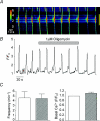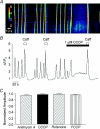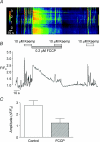Role of mitochondria in modulation of spontaneous Ca2+ waves in freshly dispersed interstitial cells of Cajal from the rabbit urethra
- PMID: 18703577
- PMCID: PMC2614037
- DOI: 10.1113/jphysiol.2008.159194
Role of mitochondria in modulation of spontaneous Ca2+ waves in freshly dispersed interstitial cells of Cajal from the rabbit urethra
Abstract
Interstitial cells of Cajal (ICC) isolated from the rabbit urethra exhibit pacemaker activity that results from spontaneous Ca(2+) waves. The purpose of this study was to investigate if this activity was influenced by Ca(2+) uptake into mitochondria. Spontaneous Ca(2+) waves were recorded using a Nipkow spinning disk confocal microscope and spontaneous transient inward currents (STICs) were recorded using the whole-cell patch clamp technique. Disruption of the mitochondrial membrane potential with the electron transport chain inhibitors rotenone (10 microm) and antimycin A (5 microm) abolished Ca(2+) waves and increased basal Ca(2+) levels. Similar results were achieved when mitochondria membrane potential was collapsed using the protonophores FCCP (0.2 microm) and CCCP (1 microm). Spontaneous Ca(2+) waves were not inhibited by the ATP synthase inhibitor oligomycin (1 microm), suggesting that these effects were not attributable to an effect on ATP levels. STICs recorded under voltage clamp at -60 mV were also inhibited by CCCP and antimycin A. Dialysis of cells with the mitochondrial uniporter inhibitor RU360 (10 microm) also inhibited STICS. Stimulation of Ca(2+) uptake into mitochondria using the plant flavonoid kaempferol (10 microm) induced a series of propagating Ca(2+) waves. The kaempferol-induced activity was inhibited by application of caffeine (10 mm) or removal of extracellular Ca(2+), but was not significantly affected by the IP(3) receptor blocker 2-APB (100 microm). These data suggest that spontaneous Ca(2+) waves in urethral ICC are regulated by buffering of cytoplasmic Ca(2+) by mitochondria.
Figures









Similar articles
-
The effects of mitochondrial inhibitors on Ca2+ signalling and electrical conductances required for pacemaking in interstitial cells of Cajal in the mouse small intestine.Cell Calcium. 2018 Jun;72:1-17. doi: 10.1016/j.ceca.2018.01.003. Epub 2018 Feb 1. Cell Calcium. 2018. PMID: 29748128 Free PMC article.
-
Mitochondrial modulation of Ca2+ sparks and transient KCa currents in smooth muscle cells of rat cerebral arteries.J Physiol. 2004 May 1;556(Pt 3):755-71. doi: 10.1113/jphysiol.2003.059568. Epub 2004 Feb 6. J Physiol. 2004. PMID: 14766935 Free PMC article.
-
Role of perinuclear mitochondria in the spatiotemporal dynamics of spontaneous Ca2+ waves in interstitial cells of Cajal-like cells of the rabbit urethra.Br J Pharmacol. 2010 Oct;161(3):680-94. doi: 10.1111/j.1476-5381.2010.00902.x. Br J Pharmacol. 2010. PMID: 20880405 Free PMC article.
-
Ca2+ signalling in urethral interstitial cells of Cajal.J Physiol. 2006 Nov 1;576(Pt 3):715-20. doi: 10.1113/jphysiol.2006.115956. Epub 2006 Aug 17. J Physiol. 2006. PMID: 16916912 Free PMC article. Review.
-
Interstitial cells of Cajal in the urethra.J Cell Mol Med. 2006 Apr-Jun;10(2):280-91. doi: 10.1111/j.1582-4934.2006.tb00399.x. J Cell Mol Med. 2006. PMID: 16796799 Free PMC article. Review.
Cited by
-
Mitochondrial calcium uptake capacity modulates neocortical excitability.J Cereb Blood Flow Metab. 2013 Jul;33(7):1115-26. doi: 10.1038/jcbfm.2013.61. Epub 2013 Apr 17. J Cereb Blood Flow Metab. 2013. PMID: 23591650 Free PMC article.
-
Functional and morphological properties of pericytes in suburothelial venules of the mouse bladder.Br J Pharmacol. 2012 Dec;167(8):1723-36. doi: 10.1111/j.1476-5381.2012.02125.x. Br J Pharmacol. 2012. PMID: 22862143 Free PMC article.
-
Calcium signalling in Cajal-like interstitial cells of the lower urinary tract.Nat Rev Urol. 2014 Oct;11(10):555-64. doi: 10.1038/nrurol.2014.241. Epub 2014 Sep 16. Nat Rev Urol. 2014. PMID: 25224445 Review.
-
Role of mitochondria in contraction and pacemaking in the mouse uterus.Br J Pharmacol. 2010 Nov;161(6):1375-90. doi: 10.1111/j.1476-5381.2010.00949.x. Br J Pharmacol. 2010. PMID: 20942856 Free PMC article.
-
Spontaneous activity in the microvasculature of visceral organs: role of pericytes and voltage-dependent Ca(2+) channels.J Physiol. 2016 Feb 1;594(3):555-65. doi: 10.1113/JP271438. Epub 2016 Jan 6. J Physiol. 2016. PMID: 26607499 Free PMC article. Review.
References
-
- Bootman MD, Collins TJ, Mackenzie L, Roderick HL, Berridge MJ, Peppiatt CM. 2-Aminoethoxydiphenyl borate (2-APB) is a reliable blocker of store-operated Ca2+ entry but an inconsistent inhibitor of InsP3-induced Ca2+ release (Review) FASEB J. 2002;16:1145–1150. - PubMed
-
- Bradley E, Hollywood MA, McHale NG, Thornbury KD, Sergeant GP. Pacemaker activity in urethral interstitial cells is not dependent on capacitative calcium entry. Am J Physiol Cell Physiol. 2005;289:C625–C632. - PubMed
-
- Burdakov D, Petersen OH, Verkhratsky A. Intraluminal calcium as a primary regulator of endoplasmic reticulum function. Cell Calcium. 2005;38:303–310. - PubMed
Publication types
MeSH terms
Substances
Grants and funding
LinkOut - more resources
Full Text Sources
Miscellaneous

